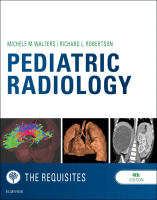Physical Address
304 North Cardinal St.
Dorchester Center, MA 02124

The “head and neck” encompasses extracranial structures from the skull base to the thoracic inlet including the orbits, nasal cavity, paranasal sinuses (PNSs), face, jaws, temporal bones and soft tissues of the neck, oral cavity, and upper aerodigestive tract. In…

The spinal cord is an integral part of the neural axis or central nervous system. Disease entities in the brain or spinal cord may have a direct or indirect influence on each other. Imaging of the pediatric spine differs from…

Imaging the Pediatric Brain The central nervous system (CNS) consists of the skull, brain, spine, and spinal cord. Imaging the brain in children differs from imaging adult patients in many respects. Ultrasound, a modality rarely used in adult neuroradiology, plays…

Imaging Techniques Radiography Conventional radiographs depict the bony detail of the skeletal system quite well and remain the mainstay in the evaluation of musculoskeletal disease. In the setting of acute trauma, radiographic views of the long bones are obtained in…

This chapter provides an introduction to pediatric genitourinary imaging for the radiology resident. It will focus on diseases commonly encountered in or specific to children and congenital anomalies. Diseases more commonly seen in adults will not be covered extensively in…

Liver and Biliary Tree Anatomy and Embryology The liver, gallbladder, and biliary tree originate from endodermal cells that form a diverticulum arising from the duodenal region of the primitive embryonic gut between 4 and 10 weeks' gestation. The larger cranial…

To the radiologist who cares for adults, the exact age of a patient is rarely of great importance. To be sure, one approaches the chest radiograph of a 30-year-old differently from that of an 80-year-old. For the most part, however,…

Congenital Heart Disease Congenital heart disease (CHD) occurs in approximately 1% of all live births, or 40,000 births annually in the United States. It remains the leading cause of birth defect–associated death in infancy. Approximately 25% of CHD defects are…

Imaging Techniques and Indications Conventional Radiography Diagnostic imaging plays an important role in the evaluation of the upper airway and chest in children. Chest radiographs comprise about 40% of all pediatric imaging, in large part because congenital and acquired respiratory…